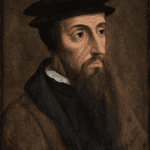Rosenstock-Huessy offers an intriguing analysis of the triumph of the “French” myth of the Renaissance (Out of Revolution, 699-705).
For starters, he gives a bleak summary of Europe between 1450 and 1517, “one of the ugliest and darkest hours of the past”: “The growth of the cities ceased all over Europe, and the men of the guilds and crafts, for lack of employment, streamed into the gangster life of the Armagnacs and Landsknechte. Petty tyrants destroyed the foundations of local rights. The Church nearly collapsed under the disillusionment of the universal councils and the wars against the Hussites. Christianity ran wild. One might almost say that the gargoyles of the Gothic cathedrals tried to become political leaders and alleged saints. One of these had his followers daily take notes on his achievements, lest they be missed or his canonization delayed. And canonized he was. Louis XI of France was only one among the refined torturers of those days. Popes killed their cardinals, and princes their brothers and fathers” (699-700).
He admits that there was a revival of Roman and Greek classics, of course: “in the Quattrocento many of the clergy saw no great harm in dressing as Romans or Greeks. Pope Julius II (1503-152) certainly did not object to be likened to Julius Caesar and a beautiful Parmesan abbess of his times can be seen on the wall of her own monastery, portrayed during her lifetime, as a Greek goddess” (700).
How did this age come to be seen as a Renaissance? Rosenstock traces it back to the French Revolutionaries, who “could no longer admit that a supernaturalist’s Reformation had decried and ended the Egyptian darkness of the Middle Ages, and began ‘modern times.’” If the Reformation initiated a new world, then the Revolutionaries themselves would have been reduced in importance. They wanted to be acknowledged as the founders of a new world that killed off the ancien one (700).
The effect was in part to detach the contours of European history from the history of the church, and to blot out the age of Catholicism’s triumph as, in Wilhelm von Humboldt’s words, “the era from the decline of taste and scientific culture until their steady and full regeneration” (701). The Enlightenment was seen as a late blooming of the Humanist project, after the unfortunate semi-darkness of the Reformation.
Thus was born the “cult” of the Renaissance. Knowledge of Renaissance art “became a kind of religious liturgy for every educated free-thinker of the nineteenth century” (702), while “laity . . . spend millions and millions of dollars on its cult; and founded numberless museums and university chairs for its study” (704).















